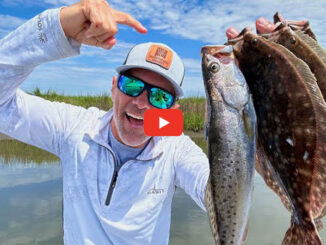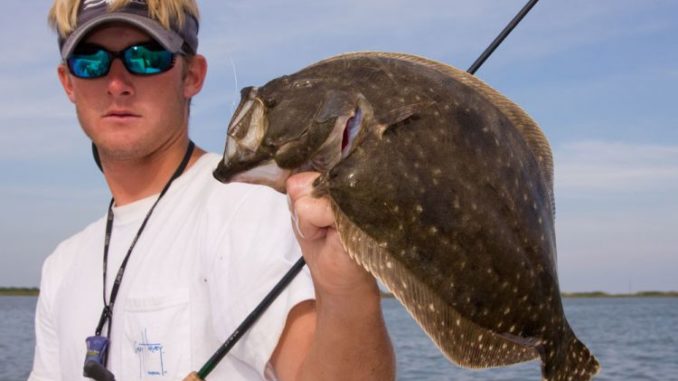
Except for Big Lake, the state’s flounder fishery — according to anglers, anyway — isn’t what it once was. But there’s still hope for a solid recovery.
If Jim Morrision thought people were strange, I wonder what he thought about flounder.
In fact, I would argue that his eternal ballad about loners, misfits and outsiders would make just as much sense if the word ‘people’ was replaced with ‘flounder.’
There’s no doubt that in waters full of oddities like tripletail, needlefish and gafftops, flounder are definitely the super freaks of the surf.
I mean we’re talking about a fish that has one eye that moves to the other side of its face, and that changes its color to match whatever mud bottom it’s lying on while waiting for unsuspecting prey to get too close.
But as freaky as they are, we love to catch them — whether on purpose or incidentally.
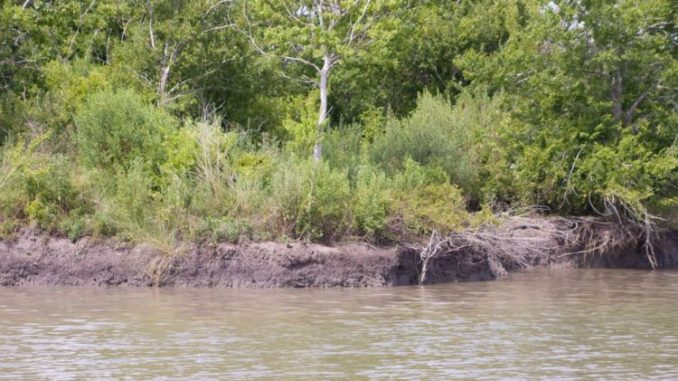
And there is typically no better time to come face to face with flounder than when their fall run begins in October as they stage in lower bays and along barrier islands before heading outside to spawn.
At least that’s what’s supposed to happen. But lately — not so much.
Fading flounder?
You don’t have to spend very long perusing internet message boards to come across folks lamenting the seeming decline of flounder over the last few years.
“The last good flounder video we made was back in 2011,” said Chas Champagne with Matrix Shad, in reference to his Dockside TV YouTube channel (https://youtu.be/GWIEDRd2Hp0). “We have not had a good flounder run on The Trestles at Lake Pontchartrain since then. Even during October and November, we considered ourselves lucky the last few years to catch two in a day.”
Champagne knows firsthand that there aren’t as many flounder around Lake Pontchartrain, but he has also talked with anglers from Venice to Delacroix to Bay St. Louis, who have told him they just aren’t catching as many flounder either.
Cade Thomas with Runaway Charters in Venice agreed with Champagne’s assessment.
“We’re not doing much on flounder,” he said. “Really haven’t in the last three years. We used to catch 20 or 30, but now it’s maybe five or six. It’s definitely fallen off a lot.”
Thomas pointed out the spot where he and I slammed the flounder a few years back just inside the first spillway, noting it wasn’t nearly as much of a guarantee as it used to be.
“The last four or five trips we’ve caught a couple while targeting redfish,” he said. “But we used to catch our limit in that first spillway. Now if we catch eight or 10 that’s pretty good. Definitely not like it used to be.”
The lack of an awesome fall flounder bite has even appeared in other typical hotspots like inside Pointe-aux-Chenes.
“Even that spot where you and Ty Hibbs smoked them by the weir a few years ago for a flounder story has been like a flounder ghost town here lately,” Champagne said. “The only place I know where people are still consistently catching flounder is Calcasieu Lake.”
Captain Mary Poe with Big Lake Guide Service concurred.
“Our spring run this year wasn’t normal because it rained over here like nobody’s business, so we had a lot of fresh water,” she said. “We still caught quite a few, though. Now last fall we waylaid them. Our fall run is usually the middle of October to the beginning of December, depending on the cold fronts. We’ve got a couple guides that strictly target flounder during the runs, and they were easily coming back with their 10-fish limits last fall.”
So what gives? Why have flounder seemingly disappeared in one part of the state while continuing to flourish in another?
At this point it would be easy to cast aspersions and point fingers at variables that we might already be mad at to begin with. Blaming them on the declining flounder fishing in Southeast Louisiana might make us feel good, but it doesn’t provide any real answers.
Flounder facts
Jerald Horst, a retired LSU fisheries biologist and frequent Louisiana Sportsman contributor, wasn’t sure he had an answer, but he did have some facts — facts that might even give hope that flounder fishing could improve just as quickly as it declined.
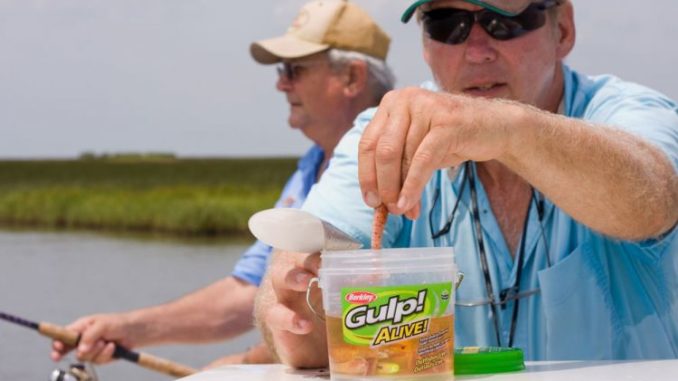
“Flounder are cool fish because they are offshore spawners, unlike trout and reds which spawn along the coast,” Horst said. “Flounder spawn in December and January, which is why the traditional great months to fish them are October and November. The reason is that’s when fish are staging as they move out to spawn.”
Experienced anglers know that fantastic fall flounder bite will last up until the first significant cold front — one that is enhanced by a big tidal range — which will flush the fish out almost overnight. Once that front hits — boom, they’re gone.
“The fish you’re catching in the fall are females and young males,” Horst explained. “Once they spawn, they separate by gender, and the males forever stay outside on the beaches. The females come back inshore after spawning, but it’s not a sudden flushing in reverse. What we get is a trickle back in during March and April.”
Horst also talked about recruitment, which measures how successfully a spawn adds harvest-sized fish back into a fishery — not how many fish total were hatched.
In other words, you can have a very successful spawn, but a weather event might kill them between the time they’re 1-inch and big enough to catch. These fish weren’t ever actually recruited into the fishery, even though every egg might have hatched.
The thing with flounder, he said, is they have a highly variable recruitment based on no particular outside factor.
“It’s just the nature of the fish,” Horst said. “Flounder recruitment is incredibly sporadic. Just picking a number, we might have some years that are 100 times more successful than the year before. Then it bottoms out the very next year. It’s almost unbelievable the huge spikes and big dips we get.”
Horst explained that if you get several consecutive years of dips, you don’t see fish like you used to. But that doesn’t mean you need to run out and declare them endangered. They’ve been around millions of years with these same highly variable recruitments.
But why is Calcasieu Lake continuing to have good flounder when the rest of the state is off?
According to Horst, the fact that every flounder there has to move out to spawn and then come back in through the ship channel means more concentrated numbers of flounder in a confined spot — even if the overall numbers might be down.
“What you’re looking at over there is a 20-foot wide band on either side of the ship channel that every fish in that system has to move through,” he said. “How many places can they leak out in Barataria Bay… you can’t intercept them as well there.”
In layman’s terms, variations in recruitment around Calcasieu Lake might be less noticeable because of the choke-point effect of the ship channel. So even if fewer flounder are moving through there, the fact that they all eventually have to stack up on one another can make for some great fishing.
Flounder fishing
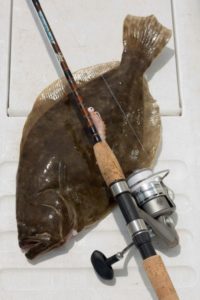
“Hopefully they’ll bounce back this fall,” Champagne said. “When they’re on, I’d consider The Trestles one of the elite flounder fisheries in the entire country. It seems like they always favor the west side of The Trestles for some reason, but that’s not written in stone.”
On a falling tide, flounder will pull up closer to the pilings on the west side, but during an incoming or dead tide, they could be 30 yards off in no-man’s land.
“If you’re on The Trestles, I’d highly recommend you fish out your cast all the way back to your boat,” Champagne said. “That way you’ll make sure you get a bait in front of them whether they’re on the pilings, or under your boat.”
Although flounder can be caught on artificial lures like spinners and soft plastics, tipping a jig with a piece of shrimp or a strip cut off a flounder belly can go a long way toward putting more fish in the boat. Smelly baits like the Berkley Gulp can also work well all by themselves.
As for the best flounder bite in the state right now at Calcasieu Lake, one of the keys to finding them is to idle along the ship channel looking for baitfish activity on the surface near the shoreline. Whenever you spot some, stop and make a few casts.
Many of the flounder caught in the ship channel come from 1 foot of water or less, but the larger, more elusive flounder are most often found a little bit deeper just out from the visible mud banks.
So the flounder freak show may have slowed down in some spots the last few years, but with any luck the last spawn might have been one of the ones Horst mentioned that was 100 times better than in previous years.
Until we know for sure, flounder probably won’t be more than an incidental catch that comes mainly while you’re fishing shrimp on the bottom for redfish.
Hopefully they’ll show up in better numbers, though. It sure would make a ‘Cajun Slam’ a whole lot easier to accomplish.
